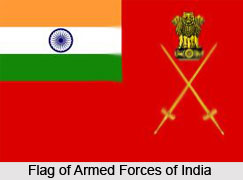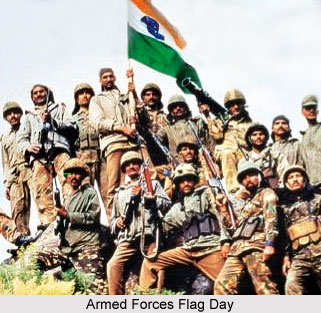 The Armed Forces Flag Day of India mark the celebration of the raising of the funds collectively for the overall development of the Indian armed forces personnel. In the August of 1949, a committee had been set under the Defence minister decided to observe a flag day annually on the December-7 Flag Day to commemorate the causes of Indian soldiers, airmen and sailors of India. From that day onwards started this grand celebration of documentation of the Indian sentiment of nationality and the elements related to this.
The Armed Forces Flag Day of India mark the celebration of the raising of the funds collectively for the overall development of the Indian armed forces personnel. In the August of 1949, a committee had been set under the Defence minister decided to observe a flag day annually on the December-7 Flag Day to commemorate the causes of Indian soldiers, airmen and sailors of India. From that day onwards started this grand celebration of documentation of the Indian sentiment of nationality and the elements related to this.
 December thrives to be month of festivities, vacations and celebrations. However, the month also has a lesser acknowledged side which is ignored socially and under the wraps of elapsed. Celebrated every year on the 7th of December, Armed forces Flag Day thrives to be the day when citizens are to be made aware of the hardships and hurdles Indian soldiers indulge in wilfully through in order to maintain peace and harmony in our country. On this day, funds are collected for the welfare and the rehabilitation of widows and the injured. Observed since 1949, this year shall be the 63rd celebration of the event.
December thrives to be month of festivities, vacations and celebrations. However, the month also has a lesser acknowledged side which is ignored socially and under the wraps of elapsed. Celebrated every year on the 7th of December, Armed forces Flag Day thrives to be the day when citizens are to be made aware of the hardships and hurdles Indian soldiers indulge in wilfully through in order to maintain peace and harmony in our country. On this day, funds are collected for the welfare and the rehabilitation of widows and the injured. Observed since 1949, this year shall be the 63rd celebration of the event.
As India earned her much desired independence, a need arose for the government to manage the welfare of its defence personnel. The idea behind observing a Flag Day was to distribute small flags to the general population and in return collect donations. Flag Day symbolizes the responsibility of the civilian population of India to take care of the families and dependents of the armed forces personnel who fight for the country.
Flag Day manifests all the three segments of the Indian armed forces, the Indian Army, the Indian Air Force and the Indian Navy which does arrange a conglomeration of shows, carnivals, dramas and other entertainment programs to bring forth to the general public the efforts of their personnel to ensure national security. Throughout the country; small flags and car flags either in red, deep blue and light blue colours representing the three Services that are distributed in return for donations.




















